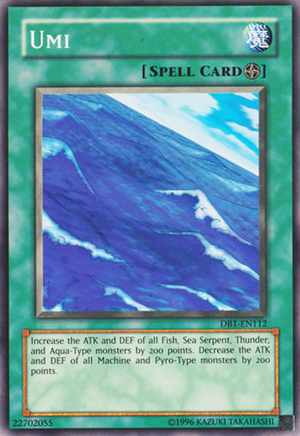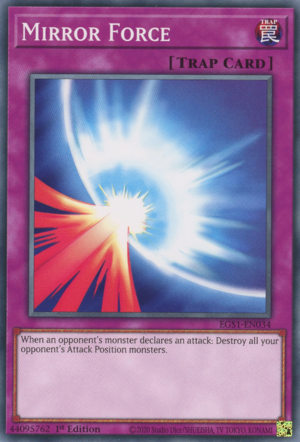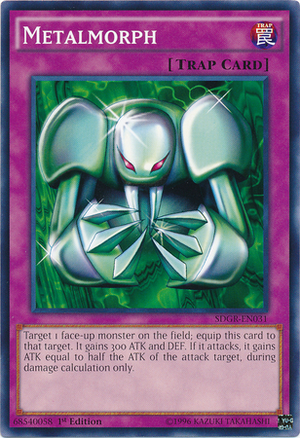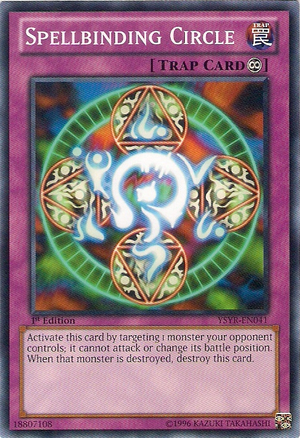How to Play Yu-Gi-Oh: Part 5
Page 1 of 1
20150612

 How to Play Yu-Gi-Oh: Part 5
How to Play Yu-Gi-Oh: Part 5
Greetings! Last time, I talked to you about Spell Cards. Today, I will be informing you about Trap Cards!
Trap Cards cannot be played directly from your hand. Instead, you must first Set them. After your opponent conducts their draw for the turn, you can activate the Trap Card, so long as any activation requirements are fulfilled. They're Spell Speed 2, so they can add to Chains. And start them.
There's only three types of Trap Cards. But first, Lief was a derp and forgot about another type of Spell Card last update! So let's fix that.






Trap Cards cannot be played directly from your hand. Instead, you must first Set them. After your opponent conducts their draw for the turn, you can activate the Trap Card, so long as any activation requirements are fulfilled. They're Spell Speed 2, so they can add to Chains. And start them.
There's only three types of Trap Cards. But first, Lief was a derp and forgot about another type of Spell Card last update! So let's fix that.

Field Spell Cards ( ) are unique in that, rather than going into a Spell/Trap Card Zone, possess their own special zone - the Field Spell Zone! Each Duelist can only have one Field Spell out at a time, but unlike every other card ever, you can replace a Field Spell with a new one! (Earlier rules - and thus games - have it so that there can only be one Field Spell Card on the field at one time - if your opponent has one, you can replace it, destroying theirs. This creates a brief gap where there's no Field Spell Card on the field; useful because some monsters, such as Earthbound Immortals, rely on the presence of a Field Spell to stay on the field. Replacing your own Field Spell Card doesn't trigger this. ...Not that it matters any more.)
) are unique in that, rather than going into a Spell/Trap Card Zone, possess their own special zone - the Field Spell Zone! Each Duelist can only have one Field Spell out at a time, but unlike every other card ever, you can replace a Field Spell with a new one! (Earlier rules - and thus games - have it so that there can only be one Field Spell Card on the field at one time - if your opponent has one, you can replace it, destroying theirs. This creates a brief gap where there's no Field Spell Card on the field; useful because some monsters, such as Earthbound Immortals, rely on the presence of a Field Spell to stay on the field. Replacing your own Field Spell Card doesn't trigger this. ...Not that it matters any more.)
 ) are unique in that, rather than going into a Spell/Trap Card Zone, possess their own special zone - the Field Spell Zone! Each Duelist can only have one Field Spell out at a time, but unlike every other card ever, you can replace a Field Spell with a new one! (Earlier rules - and thus games - have it so that there can only be one Field Spell Card on the field at one time - if your opponent has one, you can replace it, destroying theirs. This creates a brief gap where there's no Field Spell Card on the field; useful because some monsters, such as Earthbound Immortals, rely on the presence of a Field Spell to stay on the field. Replacing your own Field Spell Card doesn't trigger this. ...Not that it matters any more.)
) are unique in that, rather than going into a Spell/Trap Card Zone, possess their own special zone - the Field Spell Zone! Each Duelist can only have one Field Spell out at a time, but unlike every other card ever, you can replace a Field Spell with a new one! (Earlier rules - and thus games - have it so that there can only be one Field Spell Card on the field at one time - if your opponent has one, you can replace it, destroying theirs. This creates a brief gap where there's no Field Spell Card on the field; useful because some monsters, such as Earthbound Immortals, rely on the presence of a Field Spell to stay on the field. Replacing your own Field Spell Card doesn't trigger this. ...Not that it matters any more.)Field Spell Cards theoretically affect both players, but there are some - notably (i.e. I remember them) Skyscraper 2 - Hero City, Sorcerous Spell Wall, and The Seal of Orichalcos - that only affect the controller. In that case, they aren't much more than glorified Continuous Spell Cards. Field Spell Cards stay on the field until they are destroyed.
Like all (non-Pendulum) Spell Cards, you can Set Field Spell Cards. Like all non-Quick-Play Spell Cards, there's no real advantage to doing so (except to protect your hand, maybe?). Even under the old rules, you can't destroy a Field Spell with a face-down one. (Incidentally, you can activate a non-Quick-Play Spell Card the turn you Set it. A Set Quick-Play Spell Card cannot be activated until the start of your opponent's next turn, like a Trap Card.)
Now then, onto the meat and/or point of this post! Trap Cards! First up is, obviously, the Normal Trap Card:


Normal Trap Cards are typically like Normal Spell Cards. Use 'em, pay costs, use effect, send to Grave. However, there are some Normal Trap Cards (like Metalmorph, seen right) that function as Equip Cards - which are similar to Equip Spell Cards, but there are differences. Exact wording is still important. As with Equip Spell Cards, they'll stay on the field until the equipped monster is no longer an applicable target.


Next up are Continuous Trap Cards (still  ). Like Continuous Spell Cards, they stay on the Field until destroyed.
). Like Continuous Spell Cards, they stay on the Field until destroyed.
 ). Like Continuous Spell Cards, they stay on the Field until destroyed.
). Like Continuous Spell Cards, they stay on the Field until destroyed.Unlike Continuous Spell Cards, however, Continuous Trap Cards can possess Quick-like effects (example: Castle of Dragon Souls, right). You can use it when you activate it (this is considered the same part of the Chain as the activation of the Trap), and can then proceed to activate it whenever (even during your opponent's turn, like actual Quick effects! ...this makes sense, as Traps are Spell Speed 2. :U).
Finally, the final type of Trap Card!

Counter Trap Cards are quick. Like, really quick. How quick? They aren't Spell Speed 2. Counter Trap Cards are Spell Speed 3. As the name suggests, their purpose is to counter and negate whatever your opponent is doing. They also tend to pretty expensive to use; one requires half of your LP, another 2000. Dark Bribe, pictured above, allows your opponent to draw a card! Other times, it can be somewhat hard to use, such as The Huge Revolution Is Over. Definitely worth it if you can stop your opponent's schemes, though.
Also, I have to emphasize how important their high Spell Speed is. Cards cannot respond to a card with a higher Spell Speed than them. Granted, in most situations, you'd only want to use a Counter Trap Card to counter a Counter Trap Card. (In fact, there is a card exactly for that purpose.) Some effects - such as the Summoning of Winged Kuriboh LV9 - can only be activated on a sufficiently high enough Chain, so Counter Traps can at least stop that from happening.
And that's it for today! Next time...er, terminology and clearing up stuff like that, I guess. I'm actually running out of things to talk about. :U
Last edited by Lief Katano on 29th September 2021, 9:05 pm; edited 3 times in total

Lief Katano- : If I had a gil for all the fiends...
Gender :
Posts : 24371
Likes : 1602
Joined : 2013-01-15
Myers-Briggs Type : ~nope~
Alignment : Lawful Neutral
Location : Morioh, Japan
How to Play Yu-Gi-Oh: Part 5 :: Comments
You could give deck building tips. Maybe even a walk through in building a deck from scratch.
 Similar topics
Similar topics» How to Play Yu-Gi-Oh: Part 4
» How to Play Yu-Gi-Oh: Part 1
» Let's Play OFF: Completed!
» How to Play Yu-Gi-Oh: Part 2
» How to Play Yu-Gi-Oh: Part 3
» How to Play Yu-Gi-Oh: Part 1
» Let's Play OFF: Completed!
» How to Play Yu-Gi-Oh: Part 2
» How to Play Yu-Gi-Oh: Part 3
Permissions in this forum:
You cannot reply to topics in this forum




